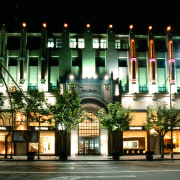Waking the dragon
As China emerges as an economic powerhouse, international companies such as Sony are finding new ways to showcase their products in this vast, untapped market

China is a country that inspires the most awesome statistics, not least of which is its population of over 1260 million people. As this vast country shrugs off its isolationist cloak and opens its borders to the rest of world, those awe-inspiring numbers keep growing.
It's estimated that during the reconstruction of Shanghai, one-fifth of the world's cranes were employed on building sites throughout the city. This dramatic increase in activity drew international corporations such as Sony, who were keen to make the statistics add up in their favour. The company's new gallery, in a refurbished 1930s building, attracted half a million visitors in its first four months.
Located in the historic French concession along the city's premier high street Huai Hai Road, the Sony gallery occupies 929m² over three storeys. Architect Eric Lagerquist says the gallery showcases the company's innovative and constantly evolving entertainment-based technology.
"It's about making up for the 50-year technology gap by presenting the Sony brand as an innovator in products that possess a functional aesthetic."
The introduction is immediate and overwhelming as the visitor steps from the cobblestone streets of old Shanghai. At the front entrance they are confronted by a 12m long tunnel lined with overlapping stainless steel sheets, which is designed to resemble the scales of a dragon.
This metal skin is hung with 20 four-foot rear projection screens, six LCD monitors and eight speakers, engulfing the visitor in an audiovisual display.
Inside the tunnel, visitors register and receive FeliCa cards. Devised by branding firm Duffy & Partners, these cards are a valuable market research tool. Visitors are encouraged to swipe their FeliCa cards at interactive display points throughout the gallery, collecting points for prizes such as free T-shirts and other Sony merchandise.
Upon emerging from the tunnel, the first exhibit is the Walkman Gallery. Designed by Duffy Asia, it shows the evolution of this iconic product since it was first introduced by Sony in the late 1970s.
The large photographic display is augmented by the actual Walkmans that were released at the time. Above each image is a directional speaker playing hit songs from that era, while on the floor light panels feature a written narrative.
A sense of history permeates the ground floor with displays of home theatre technology stretching back to 1979.
Also on this floor is a radio station that broadcasts up to two hours a week and is used as venue for interviews with visiting pop stars and other celebrities.
Studded throughout the gallery are twelve imposing columns, that Lagerquist says were originally square but were made round to enable multiple viewing sides.
"Italian glass mosaic tiles depict pixelated dragons, combining in one visual motif the ancient Chinese dragon with the modern digital age."
A small video screen embedded in each column can be programmed to play movie trailers and promotional videos.
As the visitor ascends the staircase their picture is taken so that when they arrive at the second floor their image is writ large on a white screen.
Directly opposite is a curving 9m-long counter. This is the products bar where visitors can, with the help of staff, access 200 Sony products.

"It's like asking the bartender to mix a drink. You ask for these headphones to go with that laptop and that digital camera. The staff then get everything ready for you to try," says Lagerquist.
"The snaking curves of the long table are designed to create a smooth flowing visual illusion that keeps the eye moving, while the wooden countertop provides a softer barrier in the interaction between visitors and staff."
Along with wooden countertops, track lighting signals that this is an information counter.
A floating gallery hovers above the first floor and is enclosed by glass barriers. Its cream-coloured sandstone floors and white plaster ceiling suggest an art space where innovative technology is on display.
Behind the floating gallery is a corridor with a wall punctuated with circular display panels. This connects to an area containing a freestanding laptop pod illustrated with stylised product images. This offers visitors the chance to experiment with Sony audio visual equipment.
In this space a stainless steel and glass shell functions as an interactive mobile audio display, depicting car audio, video and navigational technology. There is also a counter selling Sony merchandise, but not products to purchase Sony technology, visitors are directed to stores elsewhere in the city.
The third floor is reserved for appointment-only visitors. A home theatre is set up featuring top of the line projectors and speaker systems. There is also professional equipment on display for commercial customers, such as security systems and holographic digital advertising signage.
Meanwhile, the public, having been introduced to Sony technology, exit the building past an historic stone wall, into the bustling, ageless Shanghai street.
Credit list
Architect
Branding and environment design
Construction company
Window treatments
Graphic design
Story by: Trendsideas
Home kitchen bathroom commercial design














